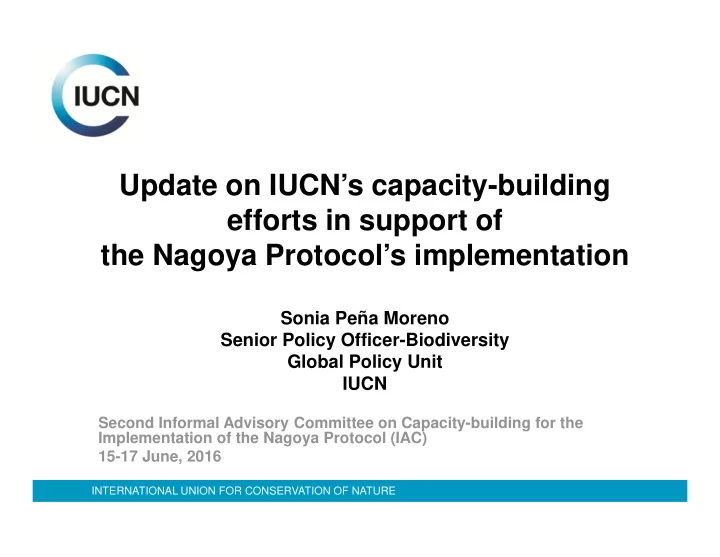

Update on IUCN’s capacity-building efforts in support of the Nagoya Protocol’s implementation Sonia Peña Moreno Senior Policy Officer-Biodiversity Global Policy Unit IUCN Second Informal Advisory Committee on Capacity-building for the Implementation of the Nagoya Protocol (IAC) 15-17 June, 2016 INTERNATIONAL UNION FOR CONSERVATION OF NATURE
Our "take" on capacity-building • Not short-term and one-off • Specifically for ABS, needs to be closely linked with long-term education • No size fits all – tailor-made (demand driven) • Hands-on, learning by doing (apply knowledge/ information for it to “stick”) • “Train the trainers” approach INTERNATIONAL UNION FOR CONSERVATION OF NATURE INTERNATIONAL UNION FOR CONSERVATION OF NATURE 2
Recent ABS-related activities • IUCN-SUR called to support ratification and implementation efforts in Ecuador and Bolivia; discussions with National Authorities (end of last year) • IUCN-Cameroun expected to provide technical assistance in a national capacity building meeting on ABS; continued support to COMIFAC Secretariat • IUCN-Nepal and IUCN ORMACC (with ELC ) have advanced on inception activities for GEF projects • IUCN ELC has been working as a consortium member of two EU marine research projects -Micro B3 and PharmaSea, contributing experiences and legal expertise on ABS INTERNATIONAL UNION FOR CONSERVATION OF NATURE INTERNATIONAL UNION FOR CONSERVATION OF NATURE 3
Capacity-building activities: Update from Latin America and Caribbean • Lessons learned: – Lack of understanding/awareness about the Protocol and ABS in general is significant (e.g. many still see the Protocol as an international framework that could provide free access to national genetic resources to big businesses without any State control) – Inter-cultural knowledge dialogue is needed for this region – Replicability of methodology (and products), based on exchanging experiences, is easy including in countries outside the region INTERNATIONAL UNION FOR CONSERVATION OF NATURE INTERNATIONAL UNION FOR CONSERVATION OF NATURE 4
Update from the COMIFAC region • Slow progress • Based on the situation analysis and the analysis of gaps and needs (2015), IUCN developed a roadmap identifying concrete actions to follow-up on the recommendations made • Roadmap (January 2016) focuses on development of a national ABS Strategy and Action Plan; development of an awareness-raising plan; capacity-development activities • 3 pilot countries- Congo, Gabon, Chad • Discussions ongoing with French Government to define the best way forward (including the funding modalities) INTERNATIONAL UNION FOR CONSERVATION OF NATURE INTERNATIONAL UNION FOR CONSERVATION OF NATURE 5
Update from Nepal • GEF MSP “Strengthening Capacities for Implementation of the Nagoya Protocol in Nepal” • Project execution modality approved by the Govt. of Nepal • IUCN will soon start the development of the project execution plan for the 30 months’ duration of the project (07.16-12.18) • Activities planned within the project include: – Conducting a gap analysis and analysis of user rights – Carrying out consultations and developing a strategy and action plan – Scoping, compiling and systematizing information to support awareness-raising and training on ABS – Developing focused training plans (citizen-scientist, negotiation skills, specific stakeholders…) INTERNATIONAL UNION FOR CONSERVATION OF NATURE INTERNATIONAL UNION FOR CONSERVATION OF NATURE 6
Update from the Caribbean • GEF project “Advancing the Nagoya Protocol in Countries of the Caribbean region” (2016-2018) • Inception workshop recently carried out • Countries approved the country-specific work plans at the Steering Committee in April • Identification of gaps and needs at country level (from national to regional approach) • Favouring legal aspects (training + legal frameworks) • Identifying knowledge and awareness gaps to plan concrete follow-up (e.g. parliamentarians and policy makers) INTERNATIONAL UNION FOR CONSERVATION OF NATURE INTERNATIONAL UNION FOR CONSERVATION OF NATURE 7
Immediate next steps • Continue discussions (internally & with existing and potential partners, increase collaboration, avoid duplication) • Match expectations- demands – funding • Establish internal ABS “working group” (“clearing house”) • Preparations for COP MOP 2 INTERNATIONAL UNION FOR CONSERVATION OF NATURE INTERNATIONAL UNION FOR CONSERVATION OF NATURE 8
Thanks! Sonia Peña Moreno Senior Policy Officer- Biodiversity IUCN Global Policy Unit sonia.penamoreno@iucn.org INTERNATIONAL UNION FOR CONSERVATION OF NATURE INTERNATIONAL UNION FOR CONSERVATION OF NATURE 9
Recommend
More recommend